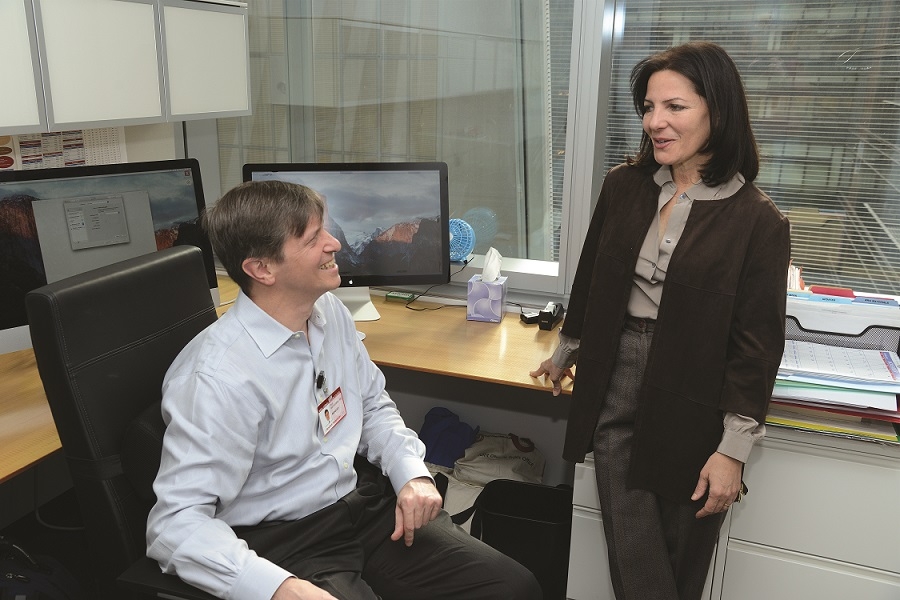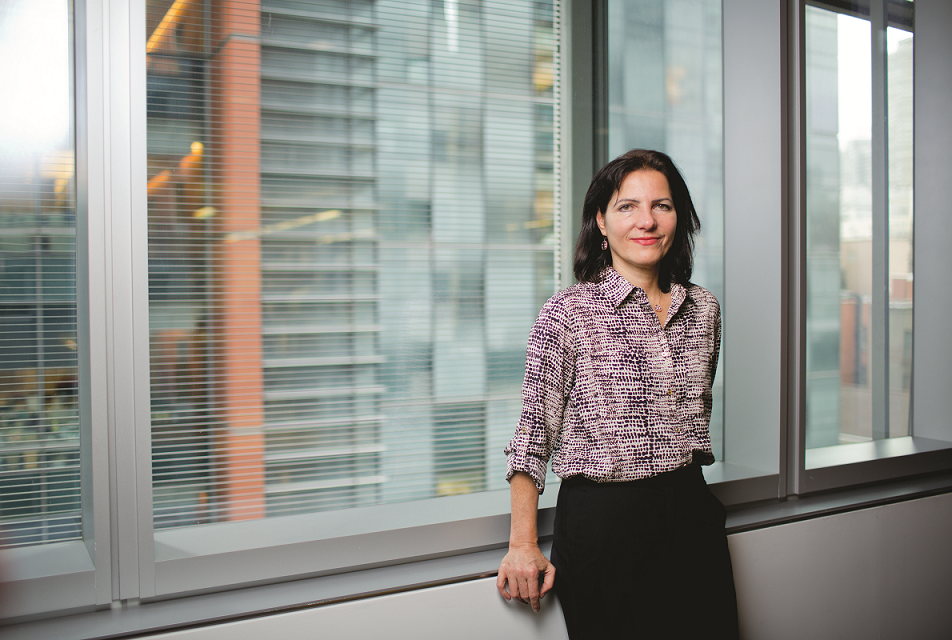By Anne Machalinski
Illustration by Jon Krause
For the past 30 years, sociologist Dr. Holly Prigerson has focused much of her research on unpacking two all-important and related questions: Why are patients so close to death typically unaware that the end is near? And why do their deaths often diverge from their wishes?
The questions have personal resonance for Dr. Prigerson, the Irving Sherwood Wright Professor in Geriatrics and co-director of the Center for Research on End-of-Life Care at Weill Cornell Medicine. Two decades ago, she was building a reputation as an iconoclast, challenging traditional ways of caring for terminally ill older adults and long-held notions of how we grieve, when her father began to die of pancreatic cancer. Despite his delirium, Dr. Prigerson recalls, the physician from Long Island knew he was dying, yet his oncologist dismissed her concerns, asserting instead that an upcoming surgery might give him more time.

Now, nearly 20 years after Dr. Prigerson’s father died, the data she’s amassed show a recurring theme that she thinks helps explain why so many of our deaths diverge from our ideals: That because patients and their loved ones are often in denial that the end is near, and doctors are reluctant to dash their hopes, they avoid honest conversations about patients’ prognoses and the likely benefits and harms of available treatments. Ultimately, patients’ involvement in their own care is undermined. As with the kind of poor doctor-patient communication she experienced during her father’s last days, many terminally ill patients and their family members are not told when death is approaching. “And if patients do not understand that, they are denied the opportunity to make informed choices, and receive the care that’s consistent with their values and preferences,” says Dr. Prigerson, a professor of sociology in medicine whose current work is supported by several National Institutes of Health grants, including a seven-year, $7 million “outstanding investigator” grant from the NIH’s National Cancer Institute.
But she believes that she’s hit upon a strategy that may increase the chances that more of us will understand our prognoses—both when cure is possible, but also when it is not. If it works, it could enable us to live and die in ways that more closely reflect our last wishes.
A Life’s Work
Dr. Prigerson was born in Brooklyn and raised in the small, suburban town of Bay Shore on southern Long Island. Her father practiced medicine in the adjacent town of Islip, and her mother left doctoral studies in English literature to pursue a master’s degree in social work. Dr. Prigerson shared her mother’s academic interest in the humanities (though for her it was as a doctoral student in history), but, ultimately, decided as her mother had to focus her studies to improve social welfare. She graduated from Barnard College with high honors in history in 1984 and was accepted to a doctoral program at Stanford. Fully immersed in her doctoral fellowship, she began having doubts about the broader public health impact she could have as an historian. “It was a very Ivory Tower existence,” she says. “I was also getting not-so-subtle messages from my parents to be more pragmatic.” After getting her master’s, Dr. Prigerson moved to the sociology department, where she had a pre-doctoral fellowship sponsored by the National Institute of Aging to study organizations, mental health and aging. For her dissertation topic, she focused on a newly established Medicare benefit, which covered receipt of hospice services of older adults in the last six months of a person’s life— which meant that patients would die more comfortably and in a home setting, if that’s what they wanted and circumstances permitted. But although surveys indicated that most patients wanted to die comfortably at home, most weren’t using the Medicare Hospice Benefit. Why? On a fundamental level, she hypothesized, they didn’t understand that they were terminally ill and had a life expectancy of only months. To Prigerson, that disconnect made total sense: “Why would patients enroll in hospice if they didn’t think they were dying?”

Dr. Prigerson with her husband, Dr. Paul Maciejewski, her partner in life and work. Photo credit: John Abbott
It was at Stanford that Prigerson met her husband and long-time collaborator, Dr. Paul Maciejewski, co-director of the Center for Research on End-of-Life Care. Dr. Maciejewski received his doctorate in mechanical engineering, then master’s degrees in statistics and philosophy. An associate professor of biostatistics in radiology and in medicine, he is instrumental in designing research that rigorously tests Dr. Prigerson’s hypotheses about what are often existential questions. “Paul is wonderful with study design, logical arguments, precise language and statistical analysis,” Dr. Prigerson says. “He’s more numerical, technically proficient, decidedly less interactive and often less ‘user friendly’; I’m more intuitive, psychosocially-minded and more communicative. He is more left brain and I’m more right brain; I’d like to think that together we have a whole brain.”
Both were in junior faculty positions at Yale when Dr. Prigerson’s father became ill. In the following decades, at Yale and then as a tenured professor of psychiatry at Harvard Medical School and an academic researcher at the Dana-Farber/Harvard Cancer Center and Brigham and Women’s Hospital—and at Weill Cornell Medicine, where the couple was recruited in 2013—Dr. Prigerson continued to look at how terminally ill patients and their physicians and caregivers engaged in end-of-life discussions. She always paid close attention to the gaps between what patients and family members actually understand about the patient’s condition, and the care that they would want if their understanding were accurate, known as patient-informed or patient-centered care. She has found myriad factors that can impede a clear understanding of one’s prognosis, including stress and anxiety; a lack of health literacy; cultural factors such as feelings of mistrust and discrimination on the basis of race or ethnicity, age, gender, or immigration status; a religious belief in miracles; and poor doctor-patient communication. The research she conducted in those years was cited by medical societies in open letters urging then-President Barack Obama to support the reimbursement of clinicians who engage in end-of-life discussions—an entitlement that Congress ultimately enacted.
But the political landscape around these issues has long been thorny. While Dr. Prigerson’s work showed that clear end-of-life discussions could give people a death aligned with their values, opponents of the Affordable Care Act said that this would translate into committees of bureaucrats deciding who’s worthy of care—the so-called “death panels.” While such an interpretation has largely fallen out of the public consciousness, in 2010 it saturated the debate with fear—and “when fear is the motivating factor, people aren’t capable of reasoning as well,” Dr. Prigerson says. “Fear overrides rational debate about the consequences of a policy.”
Today, Dr. Prigerson senses the beginning of a culture shift: Weill Cornell Medicine has been eager to support her research and share her findings—even if they suggest that physicians may need to alter the time-honored ways they practice. The results of a 2016 study she published in the Journal of Clinical Oncology, which showed that as few as 5 percent of advanced cancer patients comprehended that their disease was incurable and that they were within months of death, underscored for Dr. Prigerson the need to reimagine the script between doctors and their dying patients so that patients would better understand basic facts of their illness. Not long after, Dr. Maciejewski told her she should read up on the work of Dr. Valerie Reyna, the Lois and Melvin Tukman Professor of Human Development on the Ithaca campus. Director of Cornell’s Human Neuroscience Institute and co-director of the Center for Behavioral Economics and Decision Research, Dr. Reyna has studied how “getting the gist”—understanding the essence or core meaning of information—often helps people make better decisions. “She found you don’t really need to know all the specifics, the medical details that may make little sense and confuse a layperson,” Dr. Prigerson says, “and that in fact, less information may actually be more likely to promote a patient’s grasping the relevant medical facts.”
Almost immediately, Dr. Prigerson could envision ways to apply this concept to end-of-life communication in medicine. By getting the gist—Dr. Prigerson now uses the word as an acronym for “getting information simply and transparently”—patients should be able to participate in end-of-life conversations and achieve better outcomes, including a death that is consistent with their preferences. “Rather than discussing details about test results, lab values and medical technicalities, I want to get healthcare providers to talk to patients in ways that communicate the meaning of this information for them, which is to say how it will affect their survival, quality of life and their ability to check off boxes on their bucket list,’ because that’s what patients really want to know,” she says. For example, physicians should convey the results of a diagnostic test as simply and meaningfully as possible, clearly stating whether they indicate that the patient’s condition is better, worse or the same, and what that result suggests about how well they’re likely to function in the future.
“This is not merely an approach that uses simpler words or lower-grade reading levels,” Dr. Prigerson says. “The point is to communicate in ways that make the situation comprehensible. To borrow a term from economics, there are ‘information asymmetries’ between doctor and patient; we strive to level the playing field so that patients know enough to choose wisely the care that they would want if they better understood the choices before them.”
The ‘Gist’ in Practice
Dr. Prigerson has been pleasantly surprised that physicians from oncology, palliative medicine and critical care have been eager to collaborate on these studies, with the common aim of improving doctor-patient communication and end-of-life care. “Meeting a scientist who is interested in this topic was like hitting the jackpot,” says one of those colleagues, Dr. Lindsay Lief, an assistant professor of medicine at Weill Cornell Medicine and an assistant attending physician and director of the Medical Intensive Care Unit at NewYork-Presbyterian/Weill Cornell Medical Center. She notes that 20 percent of Americans—including people with end-stage cancer, COPD or heart failure—now die in the ICU. “Through this research, we can make a difference,” says Dr. Lief, a pulmonary critical care specialist. “We can take these issues that I care about and study them and make them better.”
These collaborations have led to research findings that point the way toward better deaths for patients, Dr. Prigerson says, such as the finding by post-doctoral associate Dr. Heather Derry that sadness and anger are related to a patient being better able to process a negative prognosis. Anxiety, shock and numbness, by contrast, are more likely to prevent a patient from fully absorbing bad news—and therefore to opt for more aggressive care that may not have meaningful benefits. Understanding how these emotions influence decision making could inform how physicians and other caregivers approach conversations with patients about the type of care they want at the end of their lives.

Dr. Prigerson with members of her research team. Photo credit: John Abbott
Dr. Prigerson emphasizes that her research should not be misunderstood as suggesting that no one should receive palliative chemotherapy (designed to prolong survival and ease symptoms, but not cure disease) or experimental treatments. But she stresses that patients should make these choices armed with accurate information, in which they understand that—based on the best available evidence—they mostly likely have months, not years, to live, that the interventions aren’t intended to cure them, and that they may result in side effects that could affect their quality of life. “When patients report a life expectancy of months, not years, they are more likely to engage in advance care planning and enroll earlier in hospice—and not within days of death when it cannot have much benefit,” Dr. Prigerson says, referring to work she collaborated on with medical student Jason Lambden ’19. In fact, Dr. Reyna’s research suggests that understanding gist allows patients to better connect with their values.
Still—as Dr. David Nanus, chief of hematology and medical oncology and the Mark W. Pasmantier Professor of Hematology and Oncology in Medicine, points out—oncologists have compelling reasons for declining to offer a specific prognosis about how long a patient will live. The most important is, simply, that these predictions often prove to be wrong. Also, while it is important to be realistic, losing all hope can have a negative psychological impact on a cancer patient. “Part of the role of an oncologist is to give patients and their families hope and try and help them cope with the many issues they have to deal with,” says Dr. Nanus, who is also an oncologist at NewYork-Presbyterian/Weill Cornell. “The last thing an oncologist wishes to do is to cause a patient to feel like they don’t have anything to live for.” New treatment options— including immunotherapies and cell therapies—are constantly emerging, although oncologists can’t always predict which patients will benefit from them. When oncologists feel that they’ve tried all the effective options and are ready to consider comfort care or hospice, Dr. Nanus says, some patients will ask about a recent news article on a novel therapy—although more often than not, it is not applicable to their cancer type.
Finally, Dr. Nanus says, there are instances in which oncologists are frank about prognosis and life expectancy, but then the patient does much better than expected. “Now it’s a year later and they’ve had this amazing response to treatment and their quality of life has been good, but then their disease progresses again,” Dr. Nanus says. “At this point, it’s as if you never had the first conversation about prognosis, and told them their cancer was incurable.”
Dr. Prigerson hopes her work will help physicians manage these concerns as they communicate with their patients. Her research has shown that discussing prognosis and end-of-life care does not make patients significantly more depressed or hopeless, nor does it negatively affect the doctor-patient relationship nor patient survival; in a 2008 study in JAMA, she found that such discussions improved the quality of care cancer patients received and enhanced their quality of life. For all patients, better outcomes can likely be achieved just by making end-of-life conversations a routine part of a primary care or specialized practice, says Dr. John Leonard, the Richard T. Silver Distinguished Professor of Hematology and Medical Oncology and associate dean of clinical research. Other approaches could include enacting policies that encourage physicians to broach these topics, or mandating that insurance companies pay for such conversations; also, hospitals could help patients complete relevant paperwork, such as an advanced directive (which documents wishes for end-of-life treatments) or a healthcare proxy (in which people appoint someone to make medical decisions for them if they’re unable to) as they’re checked in, and have them update this paperwork at regular intervals. “These big-picture discussions are important,” says Dr. Leonard, a hematologist/oncologist at NewYork-Presbyterian/Weill Cornell, “but you want to make sure they are had in the right context, and with the right person.”
Looking ahead, Dr. Prigerson is hopeful that the “gist” concept will empower patients and families with the information they need to choose care based on realistic projections, rather than overly optimistic or pessimistic ones. She recently received funding to allow a cross-campus team—including herself, Dr. Maciejewski and Dr. Reyna— to conduct research on how to apply the concept to clinical care. They aim to explore the best ways to overcome obstacles that impede a patient’s understanding of his or her medical status—be they psychological, belief-based or caused by racial, ethnic, gender or language issues—while respecting their wishes to know their prognosis. Eventually, they hope to apply for an NCI grant to fund further research on “gist” communication in end-stage cancer care. Dr. Prigerson also plans to target the racial and ethnic disparities in end-of-life outcomes—for example, by increasing the number of black and Latino patients who complete advanced directives and healthcare proxies. “No one should ever be denied their right to choose how they live their final days because of a paternalistic notion that they don’t want to know their prognosis,” she says, “or a misguided sense that someone else knows better and should decide for them.”
This story first appeared in Weill Cornell Medicine, Summer 2018 issue.

